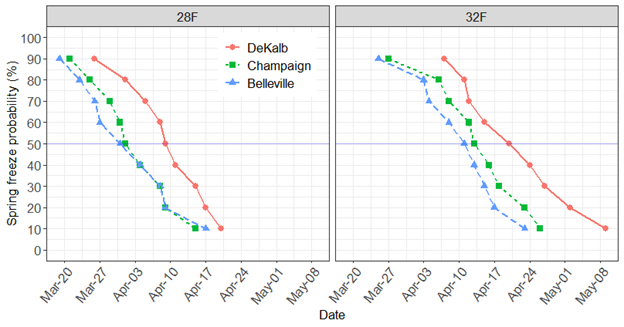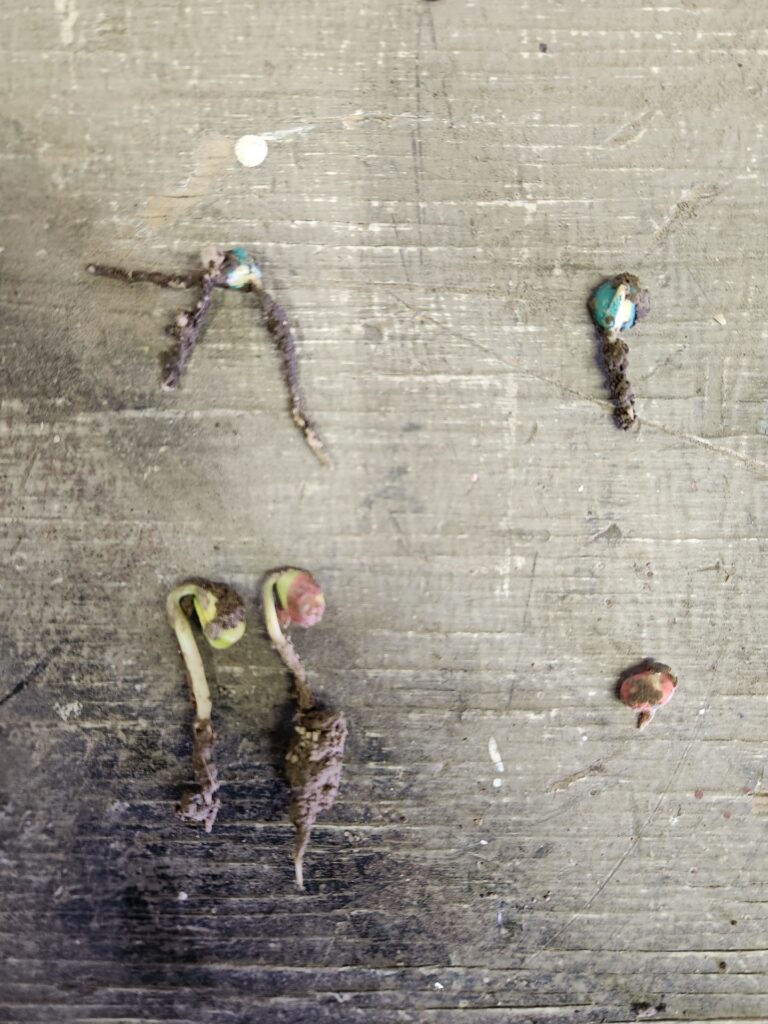Have we missed the best planting window for 2025?
You can also read the article in Portuguese and Spanish
The month of March in Illinois was 4-5 degrees warmer and 1-2 inches lower in precipitation than normal. At Champaign, 170 growing degree days (GDD) accumulated in March, and less than 2 inches of rain fell from March 10 through the end of the month. The dry weather had fields in some places dry enough to work and plant around the middle of March, and although NASS did not report any acreage of corn and soybeans planted as of March 30 (they typically use 1% as the threshold), we know that some fields were planted by the end of March. Should more have been planted?
While April was forecast to be warmer and wetter, the current near-term forecast has minimum temperatures dropping to below freezing, with highs around 50°F, in east-central Illinois next week. This doesn’t look like a formula to get planting restarted next week. Temperatures warm up after that, but we’ll have to wait to see what happens to the rainfall pattern. The old axiom that the start of corn planting should wait until “after Easter” is not very helpful this year, with Easter on April 20, almost as late as it can be.
RMA earliest planting for corn and soybeans
The earliest planting dates for replant crop insurance coverage for corn are April 1 in southern Illinois, April 5 in central Illinois, and April 10 in northern Illinois. For soybeans, they are April 5 in southern Illinois, April 10 in central Illinois, and April 15 in northern Illinois.
Spring freeze probabilities remain into April
Having the calendar turn to April has come to mean that planting time has arrived in Illinois. Planting in early April does carry some risk of frost or freeze damage, but this risk is not high enough to wait to plant if the soil is in condition to plant, at least in central and southern Illinois. Figure 1 shows the probability of spring freeze (28°F and 32°F) at DeKalb, Champaign, and Belleville over the past 30 years (1995-2024). There is a 50% chance of a daily minimum temperature reaching 32°F or lower on or after April 11 in Belleville, April 13 in Champaign, and April 20 in DeKalb. By the end of April, the probability of frost drops to 10% in Belleville and Champaign, but not until May 9 at DeKalb. A hard freeze (temperatures below 28° F) is possible in the second and third week of April, although the probability is fairly low, especially in southern and central Illinois.

Frost and freeze: how dangerous?
The fact that plants need to emerge before frost or freeze can cause serious injury or plant death provides protection against this hazard. Corn or soybean that was planted in mid-March this year has accumulated around 120-130 GDDs, which is enough to get the crop (if planted at normal depth) to emerge. Night temperatures at Champaign have been 32 degrees or less on eight days, and 25 degrees or less on three days since March 15.
The last time it was possible to plant in warm, dry soil in mid-March was in 2012: that year, about 6% of the corn crop was planted by the end of March. It emerged within a week or so and was at the V3-V4 stage when frost occurred (29 degrees) on April 11. In a planting date study at Urbana that year, corn planted on March 14 lost about half its stand to this freeze injury, and yielded about 50 bushels less than corn planted at the end of March. The late-March-planted corn was at about stage V1 when it frosted, but it suffered no stand loss and recovered well. Soybean planting in 2012 did not begin until mid-April. Of course, little rain fell in much of Illinois until July. In part because they were planted later, soybeans suffered much less yield loss than corn. In other words, it was the rainfall pattern, not planting date, that determined crop yields that year.
The most recent instance of a spring frost in Illinois occurred in mid-April in 2021. Average temperatures were several degrees warmer than normal over the first 10 days of April, then a strong cold front drove temperatures below freezing over nearly all of Illinois. Average temperatures were 5 to 15 degrees below normal from April 11-20. In a planting date trial in Monmouth, corn planted on April 22 yielded 12 bushels per acre more than corn planted on April 6 (Table 1). Soybean planted in early April showed little yield loss, but also no yield advantage from early planting; yields of both crops did not decline until planting was later than May 7.

Soil conditions at (and after) planting are equally important as the planting date
Deciding when to plant should be based on field suitability and soil temperatures at the time of, and following planting, as well as frost forecast. While cool soils alone don’t pose a significant threat to corn or soybean seeds, soils that are both cool and wet will slow germination and emergence. resulting in a greater risk of seed and seedling pathogen infection, and thus, lower plant stands. Daily maximum air temperatures need to be 70°F to accumulate 10 GDD per day, and it would take 10-12 days for the crops to emerge in this case. Seeds may be subject to “imbibitional chilling injury” if they remain in wet soils with temperatures in the low 40s for an extended period of time, such as a week or more. This condition can result in abnormal growth and poor emergence, even if the seeds survive. This is considered more of a problem in corn than in soybean, partly because more soybean seeds than corn seeds tend to die under such conditions, so they don’t show those symptoms. Lastly, planting into wet soils or ‘mudding’ in can increase the risk of sidewall compaction and poor root development and water and nutrient uptake, especially if the weather turns hot and dry after planting (soil crusting).
We have a wide optimum planting window for Illinois
While planting date responses do vary among years and sites, long-term research – along with recent studies in other states in the northern Corn Belt – shows that planting in early April may not always produce higher yields than planting in late April. In some cases, planting in early April even reduced yields, suggesting that weather conditions after planting and throughout the growing season, when the yield components are being formed, are also critical to the final yield. On average, our data show that corn and soybean achieved 99% of the maximum yield when planted between April 10 and April 30 in Illinois. Yield losses remained relatively low through the first weeks of May 15 (94% of maximum) but increased rapidly thereafter. The average maximum yield was 220 bushels/acre for corn and 70 bushels/acre for soybeans; so each 1% change in yield is 2.2 bushels/acre for corn and 0.7 bushels/acre for soybeans.
It is important to note that timely planting remains a key management goal for optimizing yields, but it’s also equally important not to do anything that might compromise the plant’s ability to take advantage of conditions later in the season that will determine actual yield. This certainly includes being cautious not to plant into cold, wet, and compacted soils in the rush to plant early.
Crop conditions from March-planted fields
Overall, soil and weather conditions after mid-March suggest that 2025 has not been an ideal year to have early-planted seeds emerge and grow quickly. While not much has been “lost” at this point, there has not been significant progress either, especially if replanting becomes necessary on those fields. As test plots, we planted both corn and soybeans on March 13 and 26 at the Orr Research Center near Perry. About 134 GDD have accumulated since March 14, and although the seeds have sprouted (Figure 2), they have not yet emerged from the soil surface. Night temperatures at Orr have ranged from 26 degrees (March 17) to 59 degrees (March 29); it is forecast to reach 29 degrees on April 7. The March 13 soybeans are very close to coming out of the ground, and we will keep a close eye on the crops to assess emergence and any potential frost injuries.
If you have fields that were planted in March, please reach out and let us know what the crop condition is, if there was any issues with emergence, establishment, frost injury, or if the fields had to be replanted.






